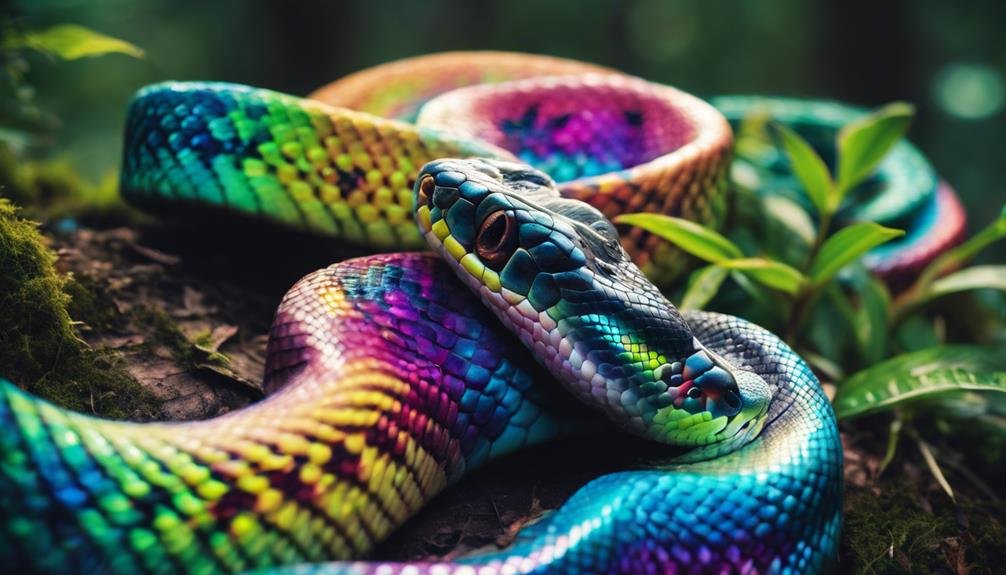The Rainbow Python unquestionably stands out with its iridescent scales and calm demeanor when considering exotic pets. Originating from regions like New Guinea, these snakes captivate reptile enthusiasts with their beauty and unique genetic morphs that enhance their vibrant colors. If you’re considering adding a Rainbow Python to your collection, you’ll need to understand their specific housing and care requirements to maintain their health and striking appearance. Curious about what it takes to keep one of these stunning creatures thriving? Let’s explore further.
Key Takeaways
- Rainbow Pythons are found in New Guinea and some Torres Strait islands. They thrive in humid forests and near water sources.
- They exhibit smooth, iridescent scales that reflect light in dazzling colors and reach lengths of 6-7 feet.
- Known for their docile nature, Rainbow Pythons are ideal pets due to their calm temperament and non-aggressive behavior.
- Their diet includes small mammals and birds, with captive diets typically consisting of appropriately sized rodents.
- Proper temperature, humidity, and regular health checks are crucial for preventing common health issues, such as respiratory infections and parasitic infestations.
Origin and Habitat
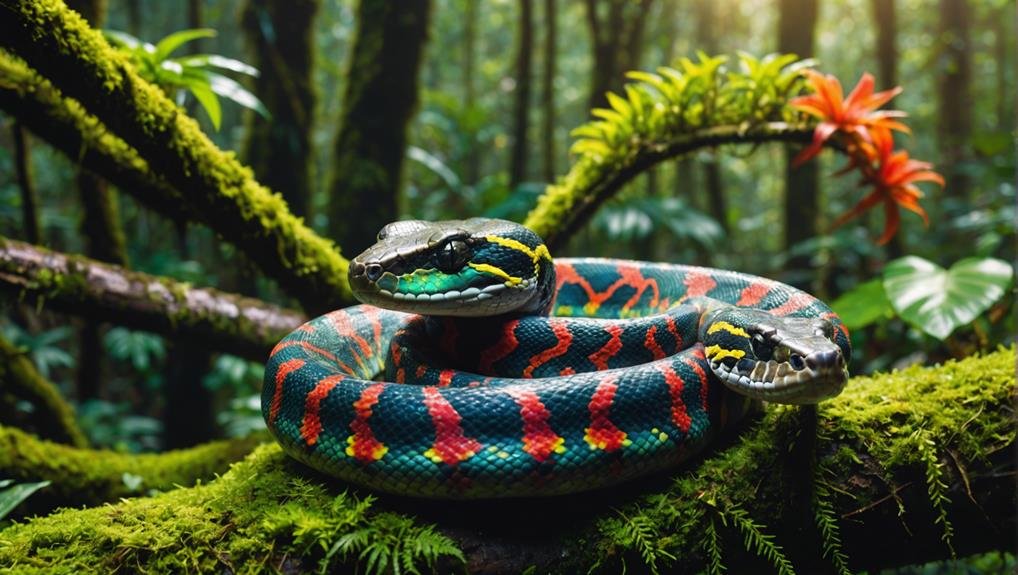

Found primarily in New Guinea and some Torres Strait islands, rainbow pythons thrive in these tropical regions. You’ll often see them in humid forests and near water sources, as they prefer environments that provide ample cover and opportunities for hunting. These areas offer a perfect blend of temperature and humidity, essential for the python’s well-being.
As a non-venomous species, these pythons rely on their strength and stealth to capture prey, typically small mammals and birds. Their habitat’s dense foliage allows them to go unnoticed by predators and prey. Their presence in such regions underscores the importance of preserving these unique ecosystems.
Previously known as Leio python Albertini, these pythons were named after Luigi DAlbertis, an Italian explorer who made significant contributions to the exploration of New Guinea. The name change to rainbow python reflects their striking iridescent scales, which make them a favorite among reptile enthusiasts.
Physical Characteristics
Rainbow pythons impress observers with their iridescent scales that shimmer in various colors. This mesmerizing effect is due to unique skin properties that reflect light, creating a stunning display that can include hints of golden hues. These pythons, particularly certain morphs and species like the white-lipped python, are a tribute to nature’s artistry. Their scales don’t just serve as a visual marvel but also play a role in their survival, offering some camouflage in their natural habitat.
When considering the physical characteristics of rainbow pythons, there are a few standout features:
- Scales: Their scales are smooth and overlap to enhance their iridescent quality, causing light to refract into dazzling colors.
- Size: Like most pythons, they’re constrictors and can grow to impressive lengths, with some individuals reaching up to 6-7 feet, making them a formidable presence.
- Non-venomous: These pythons subdue their prey through constriction, applying pressure until their prey suffocates, rather than using venom.
Breeding efforts continuously aim to enhance these captivating traits, producing pythons with even more vibrant and shimmering scales. Whether you’re an enthusiast or a collector, the allure of a rainbow python is undeniable.
Color Variations
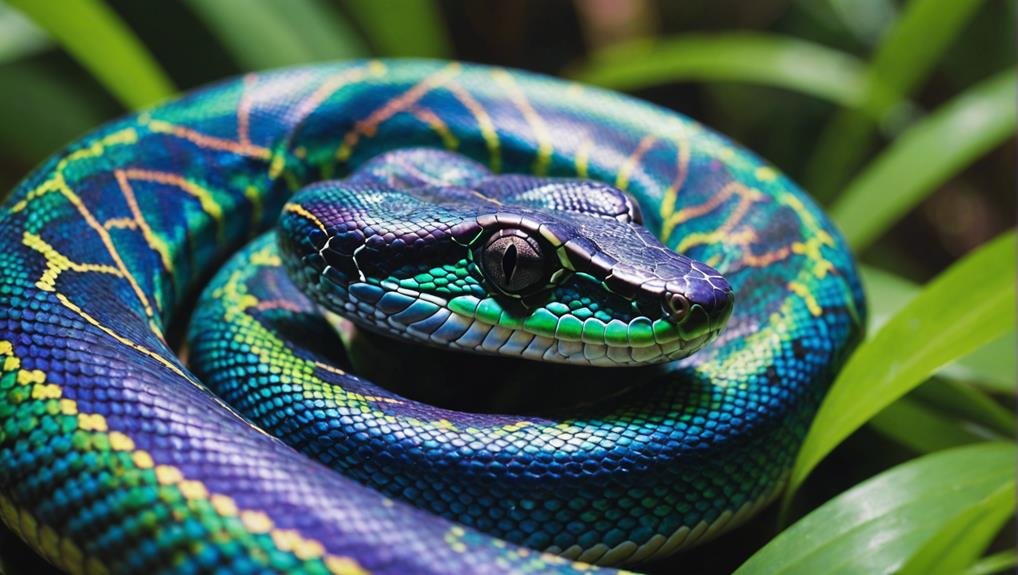

Among the most mesmerizing aspects of rainbow pythons are their striking color variations, influenced by unique genetic morphs. These incredible snakes display a range of hues, primarily due to genetic twists that affect their iridescent scales. You’ll often see them shimmering with a beautiful sheen, similar to the white-lipped python. This radiance is one of their most alluring features, making them appealing to reptile enthusiasts.
Selective breeding plays an essential role in accentuating these color variations. Breeders aim to replicate and enhance luminosity depth, focusing on specific genes like the golden child gene. This gene, in particular, contributes to a darker overall appearance but with a stunning, almost metallic sheen that catches the light in fascinating ways. It’s no wonder breeders and collectors seek out these specific morphs.
Depending on the morphs and their color variations, the availability and cost of rainbow pythons can differ significantly. Some morphs are rarer and more costly, making them prized collector possessions.
Each species of rainbow python showcases unique patterns and colors, ensuring that no two are exactly alike. The diversity in their appearance makes them a visually alluring addition to any reptile collection.
Behavior and Temperament
You’ll appreciate rainbow pythons’ docile nature and calm temperament, making them an excellent choice for reptile enthusiasts. These pythons aren’t aggressive and are generally easy to handle, especially when properly cared for and socialized. Here are three reasons why rainbow pythons are so beloved:
- Non-aggressive demeanor: Rainbow pythons are more likely to retreat or curl into a defensive posture than to hiss or strike when they feel threatened.
- Solitary behavior: They prefer basking, hiding, or exploring their enclosures, making them low-maintenance pets.
- Ease of handling: Regular handling and a suitable environment help maintain their relaxed and gentle nature.
Rainbow pythons’ calm temperament makes them ideal subjects for social media posts, showcasing their beautiful iridescent scales without the risk of sudden aggression.
Their solitary nature means they aren’t constantly seeking attention, allowing you to manage their care easily.
Ensuring a stress-free environment and regular interaction will help keep your rainbow python happy and well-adjusted.
Whether you’re new to reptile care or an experienced herpetologist, rainbow pythons are a rewarding and manageable addition to your collection.
Diet and Feeding
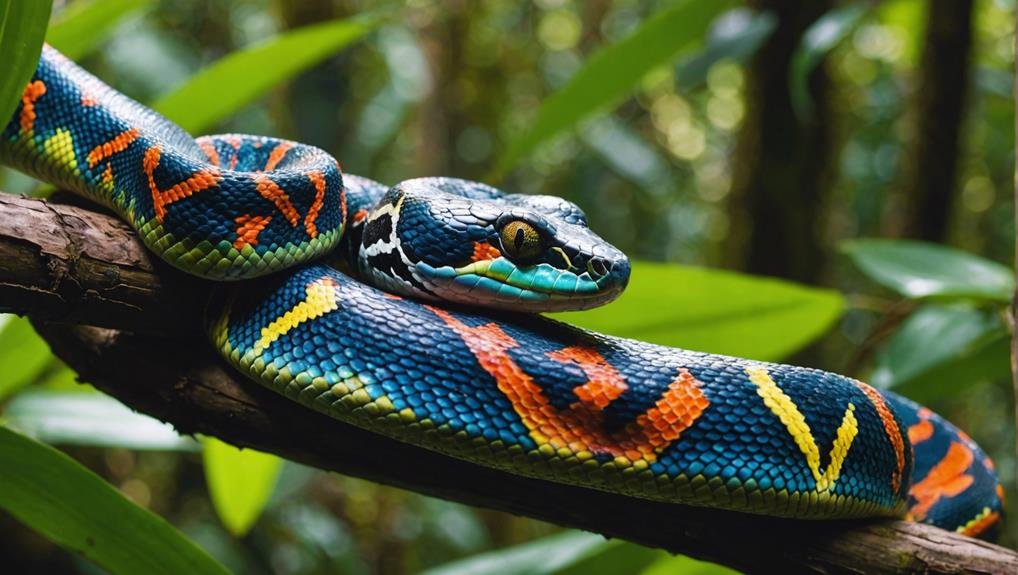

An essential aspect of caring for rainbow pythons is providing them with a proper diet that mimics their natural feeding habits. Rainbow pythons primarily feed on small mammals, birds, and occasionally reptiles in the wild. When kept in captivity, their diet usually consists of rodents like mice and rats. These pythons are constrictors, so they’ll use their muscular bodies to squeeze and suffocate their prey before swallowing it whole.
Offering appropriately sized prey items is important to ensure your rainbow python’s health and well-being. Generally, the prey should be no larger than the widest part of the snake’s body. Feeding frequency is higher for young pythons, typically once every 5-7 days. The feeding frequency drops every 1-2 weeks as they grow and become adults.
Monitor your python’s condition and adjust the feeding schedule and prey size accordingly. Overfeeding can lead to obesity and health issues, while underfeeding can cause malnutrition.
Housing and Care
After establishing a proper diet for your rainbow python, it’s equally important to provide a well-designed enclosure that meets their housing and care needs. Rainbow pythons require spacious enclosures with proper heating and lighting to mimic their natural habitat. To guarantee your snake thrives, focus on the following key aspects:
- Temperature and Humidity: Maintain a temperature gradient with a warm side of around 85°F and a cooler side of about 75°F. Use a reliable heating source and thermostat. Keep humidity levels between 50% and 70% to support respiratory health and proper shedding.
- Enclosure Setup: Provide ample hiding spots and climbing branches. These elements help your rainbow python feel secure and exhibit natural behaviors. Opt for a substrate that retains humidity, such as cypress mulch or coconut fiber.
- Monitoring and Maintenance: Regularly check temperature, humidity, and overall health. Clean the enclosure routinely to prevent bacterial growth and ensure a hygienic environment.
Breeding Rainbow Pythons
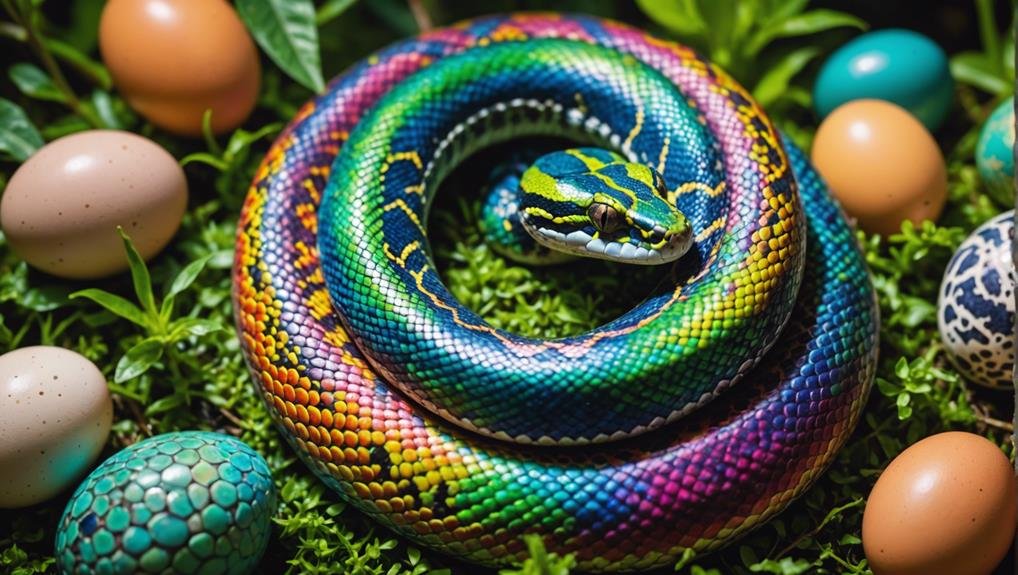

Breeding rainbow pythons requires careful selection of genetic morphs to enhance their iridescent scales and replicate desirable traits. You’ll want to focus on specific genes like the motley gene and golden child morph to achieve stunning results. Selective breeding amplifies the depth and vibrancy of their iridescent scales and guarantees the replication of other desirable traits.
Here’s a handy table to help you understand the key genetic morphs involved:
| Genetic Morph | Key Trait |
|---|---|
| Motley Gene | Enhances pattern and iridescence |
| Golden Child | Deepens color and sheen |
| Sunfire | Intensifies brightness |
| Albino | Alters pigmentation |
| Titanium | Unique metallic sheen |
When selecting breeders, aim for pairs that complement each other’s traits. For example, pairing a motley gene python with a golden child morph can produce offspring with exceptional iridescence and unique patterns. This approach attracts enthusiasts and collectors and maintains the rarity and cost-effectiveness of rainbow pythons in the market.
Common Health Issues
While breeding rainbow pythons can be incredibly rewarding, it’s equally important to be mindful of common health issues affecting their well-being. Like with ball pythons, maintaining proper care and vigilance can help prevent many health problems.
- Respiratory Infections: These are often caused by improper humidity levels or temperature fluctuations. Signs include wheezing, nasal discharge, and lethargy. Ensure your python’s enclosure maintains consistent temperature and humidity to prevent these infections.
- Parasitic Infestations: Mites and ticks are common parasites that can affect your rainbow python. They can lead to skin irritation and secondary infections if not treated promptly. Regularly check your python and its enclosure for signs of parasites and use appropriate treatments if necessary.
- Obesity: Overfeeding can lead to obesity, which in turn can cause fatty liver disease and decreased mobility. Monitor your python’s diet and ensure it’s receiving the right amount of food. Avoid feeding too frequently and stick to a balanced diet rich in essential vitamins and minerals.
Taking proactive steps in these areas will help your rainbow python thrive and avoid common health issues. Always prioritize their health and consult a reptile vet if you notice any concerning symptoms.
Conclusion
Caring for Rainbow Pythons is a rewarding experience that combines beauty and serenity. With their dazzling scales and calm demeanor, these snakes are a joy to observe and handle.
You can guarantee their health and happiness by providing the right environment, diet, and attention. Whether you’re a seasoned reptile enthusiast or a newcomer, the alluring charm of Rainbow Pythons will surely enhance your appreciation for these remarkable creatures.

